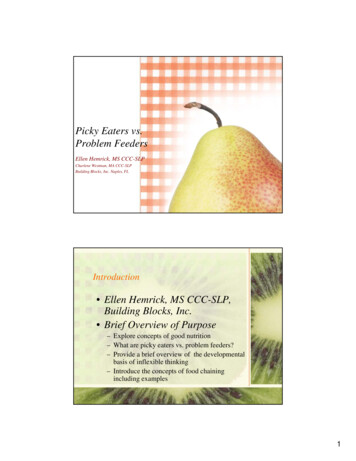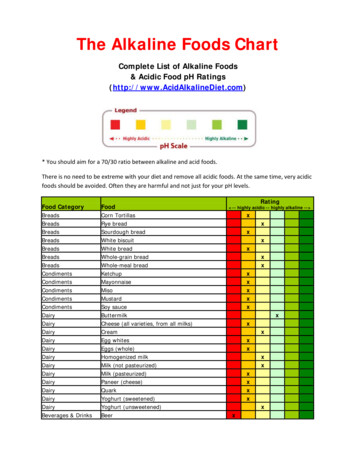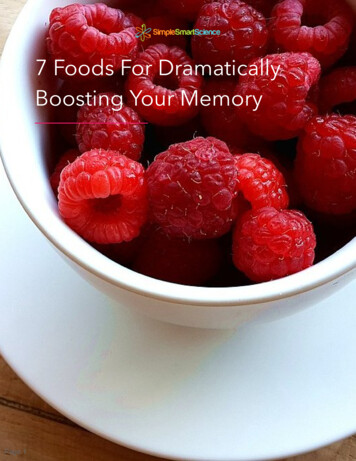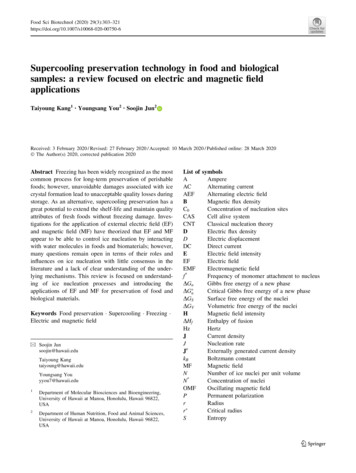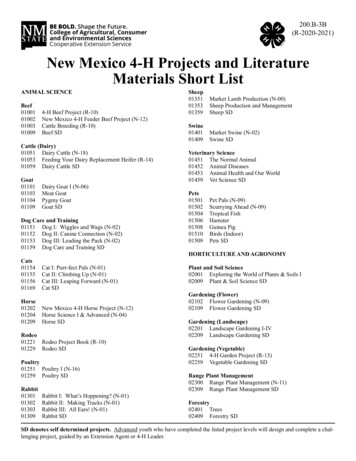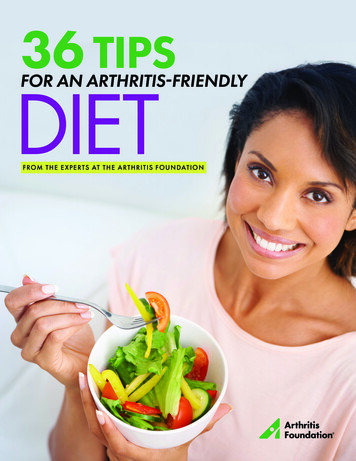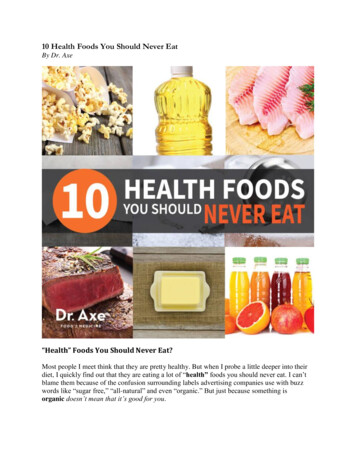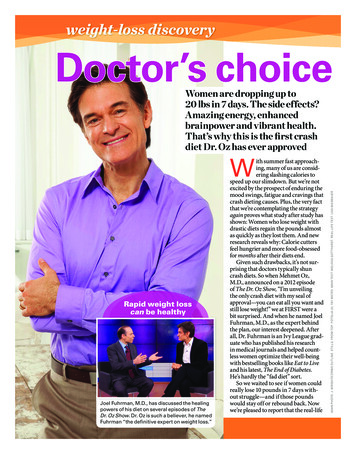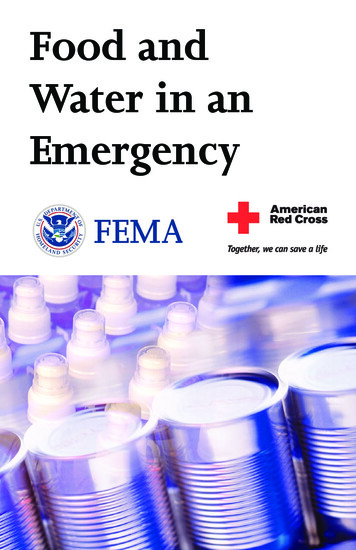
Transcription
Archival copy. For current version, see: eezingconvenience foodsthatyou’vepreparedat homePNW 296By C. Raab and N. OehlerYour freezer can help you prepare for busy daysahead, parties, or unexpected company. Byplanning a steady flow of main dishes, bakedgoods, desserts, and other foods, you can make gooduse of your freezer and your time.Benefits of freezing convenience foods include: You prepare food when you have time. You use your oven more efficiently by baking morethan one dish at a time. You avoid waste by freezing leftovers to use as“planned overs.” You can prepare special diet foods and baby foods inquantity and freeze them in single portions. You save time by doubling or tripling recipes andfreezing the extra food. If you normally cook for just one or two, you canfreeze individual portions of an ordinary recipe forlater use. You can save money by making convenience foodsyourself.On the other hand: Freezing is expensive when you total the cost ofpackaging, energy use, and the freezer itself. You use more energy to cook, freeze, and reheat adish than you would use to cook it for immediateconsumption. Prepared foods have a relatively short storage lifecompared to the storage life of their ingredients(such as frozen fruits, vegetables, and meat). Unless you have a microwave, you must allowplenty of time for thawing. Some products don’t freeze well. Others don’t justifythe labor and expense of freezing.A Pacific Northwest Extension PublicationOregon State University Washington State University University of Idaho
Archival copy. For current version, see: ntentsPreparing foods for freezing.2Freezer storage.2From the freezer to the table.3Refreezing frozen foods that have thawed.3Convenience foods that do not freeze well.4Baked products and doughsBaked quick breads.4Yeast breads and coffee cakes.5Cakes.5Cookies.6Pastry.6Pies and crisps.7Main dishes and meals.8–9Meal in a bag.9Eggs.10Sandwiches.10Soups. 11Fruit dishes. 11Vegetable dishes.12Desserts and sweets.13For more information.14Preparing foods for freezingIf you aren’t sure how well a prepared food freezes,try freezing just a small portion the first time and checkto see whether the quality is acceptable. Some foods donot freeze well (see page 4).Foods to be frozen should be slightly undercookedif you’ll reheat them after freezing. Cool them quicklyto ensure safety and freshness. To speed cooling, putthe pan containing the prepared hot dish (such as amain dish or sauce) in a pan or sink of ice water. Stirevery 5–10 minutes. This is especially important whenpreparing large amounts of food. Keep the water coldby changing the ice as needed. You also could put thefood into serving-size freezer containers and refrigeratethem until cool. Package and freeze as soon as the foodis cool.Packaging Pack foods in amounts you will use at one time. Select packaging suited to the thawing and reheatingmethod you’ll use. Foods in most packaging can bethawed in the refrigerator (or at room temperature ifnot perishable). Use freezer- and microwave-ovensafe containers to package foods that will bethawed and/or reheated in a microwave oven.2 Use moisture-vapor-resistant packaging such as plastic containers, freezer bags, heavy-duty aluminumfoil, and coated freezer paper to preserve the qualityof frozen food. Wide-mouth glass jars designed forcanning and freezing also can be used. In glass jars, leave 1–2 inches space (headspace)between the food and the lid for expansion.Otherwise, jars will break. Convenience foods can be frozen in glass or metalbaking pans lined with plastic wrap or foil. When thefood has frozen, remove it from the container andwrap it in freezer paper or put it in freezer bags. Foods also can be vacuum-packaged in vacuum-sealbags or glass jars. The more oxygen removed fromthe container, the better the food quality. However,removing oxygen does not prevent bacteria fromgrowing, so it’s important to keep perishablevacuum-sealed foods cold when thawing. Note:Vacuum-sealed bags are not designed for cookingthawed foods.Many vacuum sealers are on the market. Some aremore effective at removing oxygen than others.Check consumer guides for best choices. Rememberto figure in the cost of the replacement bags whendeciding whether to purchase a vacuum sealer foryour frozen convenience foods. Label each package with the name of the food, thedate, and reheating information.Freezer storageFreeze prepared foods at 0 F or below. For quickest freezing, place the packages against the coolingsurfaces of the freezer. Freeze only the amount of foodthat will freeze within 24 hours. This is usually2–3 pounds of food per cubic foot of freezer space.After the food freezes, rearrange the packages andstore frozen foods close together.It’s a good idea to post a list of the frozen foods withfreezing dates near the freezer. Check packages off thelist as you remove them.Suggested storage times are in the tables (seepages 4–13). Foods stored longer will be safe to eatif the freezer has worked properly, but they may havepoorer quality (texture, color, nutritive value). Usingappropriate packaging and storing in a chest freezerwill maximize the quality of frozen foods.Freezing convenience foods
Archival copy. For current version, see: om the freezer to the tableThere are different ways to prepare frozen foods forthe table. (See thawing and reheating recommendationsfor specific foods.) You can reheat thawed foods in aconventional oven. A microwave can both thaw andreheat. A microwave is convenient and fast, and thefood doesn’t stick to the container.Foods that were cooked and frozen should bereheated to 165 F. It’s helpful to use a thermometer toensure that foods reheat properly without overcooking.Use an ovenproof thermometer, or test the temperatureof the food after removing it from the oven.Thawing at room temperatureNonperishable foods (such as breads, most cakes,and cookies) can be thawed at room temperature. Leavethem in their packaging.Thawing in the refrigeratorThawing in the microwaveMost frozen convenience foods are best if thawedbefore cooking in the microwave. Use a low-powerdefrost cycle followed by a cycle at higher powerto cook and heat the food. Frozen vegetables can becooked successfully without thawing.Porous foods such as breads thaw very quickly andcompletely in the microwave on the defrost setting.Do not overcook. Foods with uneven moisture contentor composition require careful attention so that outersurfaces do not overcook while the center of the food isthawing.Follow the directions for thawing and heating thatcome with your microwave. A general guideline is thatit will take about 6–8 minutes for each pound of foodthawed at a defrost setting (30 percent power). Thefood may need to be rotated or turned over halfwaythrough the defrosting time.Thaw perishable foods (such as main dishes, cookedmeat, side dishes, and eggs) in the refrigerator to prevent bacterial growth.Refreezing frozen foodsthat have thawedIf foods still contain ice crystals, or if they havebeen completely thawed less than 2–3 hours, they canbe refrozen safely. However, refrozen foods will beof lower quality than when originally frozen. Bacteriacan grow if perishable foods are not kept cold. Ifthawed foods have been at room temperature morethan 2–3 hours, they may not be safe to eat, asexplained below.Frozen, uncooked foods thawed and kept at room temperature longer than 2–3 hoursFruits, raw; fruit juice concentratesSafe but might be inedible due to fermentation.Meat, raw, including hamburger, poultry,variety meats (for example, liver, kidney, heart),fish, and shellfishDiscard if meat, poultry, or fish do not feel cold.Be careful to avoid contaminating other foods andfood preparation areas with drippings from raw meator fish.Frozen, prepared and cooked foods thawed and kept at room temperature longerthan 2–3 hoursFruit piesSafe; might be poor quality due to fermentation.Meats, cooked (including ham)Unsafe; discardVegetables, blanched or in sauceUnsafe; discardSoupsUnsafe; discardMeat, poultry, and fish pies, “dinners,”and similarly prepared dishesUnsafe; discardIce cream and sherbetUnsafe; discardFreezing convenience foods3
Archival copy. For current version, see: nvenience foodsthat do not freeze wellCharts on this and following pages note “problem foods” which might notfreeze well. Here are some others: Potato salad Macaroni salad Fried foods Milk sauces and gravies (especially thosethickened with corn starch or flour) Sour cream Mayonnaise or salad dressing Crumb toppings Gelatin Fruit jelly Block of cheeseBaked products andBaked quick breadsProblem foods: Unbaked biscuits will be smaller and less tender.Unbaked muffins are likely to have poor Suggestedstoragetime(at 0 F)*BiscuitsBake as usual. Cool. Package.To serve hot, heat unthawed at350 F, 15–20 minutes; or microwave10–15 seconds per biscuit.2–3 monthsQuick breadsBake as usual. Bake to light(gingerbread, nutbrown. Cool quickly. Package.and fruit bread,coffee cake)Thaw in wrapping at room temperature.Slice fruit and nut breads while partlyfrozen to prevent crumbling.2–4 monthsDoughnutsMake as usual. Cool. Package.(Glazed doughnutsmay lose glazewhen frozen andthawed)Thaw at 400 F, 5–10 minutes, or inwrapping at room temperature.Dip glazed doughnuts in granular sugarafter thawing, if desired.3–4 weeksMuffinsBake as usual. Cool. Package.Thaw at room temperature,1 hour. Or, heat unthawed at 300 F,20 minutes. Or, microwave10–15 seconds per muffin.2–3 monthsWafflesHeat without thawing in a toaster,under broiler, or on baking sheetat 400 F, 2–3 minutes.1–2 monthsBake to a light brown.Wrap individually or in pairs.*Foods stored longer than the recommended times will be safe but may be of less acceptable quality.4Freezing convenience foods
Archival copy. For current version, see: ked products and doughs—continuedYeast breads and coffee cakesFoodPreparingandpackagingThawing and heatingBread, rolls,Bake as usual. Cool quickly.sweet rollsPackage.Suggestedstoragetime(at 0 F)*Thaw at room temperature. To reheat,wrap in aluminum foil, heat at 300 F,15 minutes (5–10 minutes for rolls)or microwave without foil at low power.4–6 weeksBrown andserve rollsMake as usual, but let rise slightlyThaw at room temperature in wrappingless after shaping (about 30 minutes). 10–15 minutes. Unwrap. Bake at 400 F,Bake at 325 F, about 40 minutes.10 minutes or until light brown.Do not brown. Remove from panCool. Package and freeze.4–6 weeksUnbaked coffeecakes, bread,and rollsUse recipes especiallyFollow the recipe directions.developed for freezing the dough.See www.breadworld.com/for recipes that can be shaped andfrozen without baking (includingfreezer rolls, pecan sticky buns,and a cheese coffee cake).Up to1 month*Foods stored longer than the recommended times will be safe but may be of less acceptable atingAngel food,chiffon,sponge cakesSuggestedstoragetime(at 0 F)*Bake as usual. Cool.Frosted or filled: Unwrap and thaw inFrosted: Freeze before wrapping.refrigerator.Do not use egg-white frosting.Unfrosted: Thaw in wrap on rackUnfrosted: Wrap and freeze. If1–2 hours at room temperature.freezing slices, place a doubleIf wrapped in aluminum foil, can thawlayer of freezer wrap or foilat 300 F, 15–20 min.between slices.Egg-whitecakes:4–6 weeksWhole-eggcakes:4–6 weeksEgg-yolkcakes:2 weeksRegular layeror sheet cakes4–6 weeksBake as usual. Cool. For bestSame as above.results, freeze cake and frostingseparately (see Frostings, page 13).CupcakesBake as usual. Cool completelybefore wrapping. Package.Thaw at room temperature for 1 hour.If unfrosted, wrap in aluminum foil andthaw at 300 F, 10 minutes.4–6 weeks*Foods stored longer than the recommended times listed will be safe but may be of less acceptable quality.Freezing convenience foods5
Archival copy. For current version, see: ked products and doughs—continuedCookiesFoodCookies, heatingSuggestedstoragetime(at 0 F)*Bake as usual. Package in rigidThaw in wrapping,4–6 weekscontainers with freezer paper or15–20 minutes.waxed paper between layers.Cookies, unbaked: RefrigeratorForm dough into roll.Slightly thaw dough and slice.cookiesBake cookies without thawing,according to recipe. Drop cookiesDrop cookie dough on baking sheetand freeze. When frozen, packagedough balls in freezer bags.Freeze dough in bulkin a freezer container.2–3 monthsBake cookies without thawing at 400 F,about 10–15 minutes.Thaw bulk dough at room temperatureuntil soft enough to drop by teaspoonfuls.Bake as usual.*Foods stored longer than the recommended times will be safebut may be of less acceptable quality.PastryFoodPastry gSuggestedstoragetime(at 0 F)*Make regular pastry or crumb crust.Fit in pie pans. Prick regular pastry.Stack pie pans with two layers offreezer paper. Put all in freezer bag.Or, store flat rounds on lined cardboard with two pieces of freezerpaper between each.Bake still frozen at 475 F, until lightbrown. Or, fill and bake as usual.4–6 weeksDough also can be frozen in a ballin amounts for one crust.Thaw dough. Roll out and bake as usual.6–8 weeksThaw in wrapping at room temperature,10–20 minutes.4–6 weeksPastry crust,Bake as usual. Cool. Package.baked*Foods stored longer than the recommended times will be safe but may be of less acceptable quality.6Freezing convenience foods
Archival copy. For current version, see: ked products and doughs—continuedPies and crispsProblem foods: Custard and cream pies soak into the crust.Meringue on pies toughens and sticks to the gestedstoragetime(at 0 F)*Fruit crispsPrepare crisp in a baking pan.Cover with lid or foil.Bake frozen crisp in a 375 F oven for40–60 minutes or until heated through.3–4 monthsPies, unbaked(fruit, mince, nut): Uncooked filling(Note: unbakedfresh pies have abetter fresh fruitflavor than frozenbaked pies, butthe bottom crusttends to getsoggy)Make as usual except add 1 extraCut vent holes in upper crust. Put panTbsp. flour or tapioca or 1 2 Tbsp.on cookie sheet. Bake without thawingcornstarch to juicy fillings toat 450 F, 15–20 minutes. Thenprevent boiling over during baking. reduce to 375 F, 20–30 minutesDon’t cut vents in top crust.or until top crust is brown.Steam and cool light fruits (suchas apple, peach) first to preventdarkening. Freeze in pan. Package.Fruit fillings may be cookedand cooled before adding to crust.Fruit pies:3–4 monthsMince pies:6–8 monthsNut pies:3–4 monthsFruit pies,unbaked: Cooked fillingMake filling using Clear Jel**starch (1 4 cup per quart of fruit).Freeze in jars or cartons, leaving1 inch headspace. Or, put thecooled filling into an unbaked piecrust and freeze. Package.Thaw the frozen filling and put in acrust. For an unbaked crust, bake at425 F, 30–40 minutes or untilgolden brown.3–4 monthsLet stand at room temperature about15 minutes. Then heat in 350 F ovenuntil warm, about 30 minutes.2–3 monthsFoodPies, bakedBake as usual. Cool rapidly. Freeze(fruit, mince, nut) before packaging. Pies are easierto wrap after freezing.Pumpkin pie,unbakedPrepare pie shell and filling as usual. Bake without thawing at 400 F,Have filling cold before adding to10 minutes. Then reduce to 325 F tounbaked, chilled pie shell.finish baking.Freeze in pan. Package.4–5 weeks*Foods stored longer than the recommended timeswill be safe but may be of less acceptable quality.**A modified food starch used commerciallyto thicken foods. Ask the Extension officein your county about sources of Clear Jel.Freezing convenience foods7
Archival copy. For current version, see: in dishes and mealsMeat, fish, poultry, pastaProblem foods: Plain cooked macaroni, spaghetti, and rice do not freeze gestedstoragetime(at 0 F)*Meats or fish,creamedMake as usual. Cool quickly inrefrigerator. Package.Thaw in refrigerator or microwave.Stir occasionally to make smooth.1 monthMeats andFry as usual until almost done.poultry, friedCool quickly. Freeze on trays.(May lose somePackage.fresh flavor andcrispness whenfrozen)Thaw in refrigerator or microwave.Place in shallow pan and heat without acover at 350 F, 30–45 minutes; or thawand cook in microwave, followingmanufacturer’s instructions.1–3 monthsMeats, groundCook as usual. Package in mealsize portions.Thaw in refrigerator (allowing about24 hours for each 5 pounds of meat)or heat slowly on top of range or in oven.Cook to 160 F.1–2 monthsMeat loaf,Prepare as usual. Do not putbaked orbacon strips on top. Bake if youunbakedwish. Package.Unbaked: Unwrap. Bake at 350 F tointernal temperature of 160 F(about 11 2 hours).Baked: To serve cold, leave wrappedand thaw in refrigerator. To reheat,unwrap and bake unthawed at 350 F,about 1 hour or until all meat is hot.3–4 monthsMeat, roasted(beef, pork,or poultry)(Note: ham andother cured meatslose color andbecome rancidmore quicklythan other meats)Roast as usual. Remove as much fatas possible. Keep pieces large.Cut turkey and other large fowlfrom the bone to save space.For short storage, package withoutsauce or gravy. To keep slicedmeat from drying out, cover withgravy, sauce, or broth. Packagein rigid containers.Thaw meat in wrapping in refrigerator.If in aluminum foil, heat at 325 F,15–20 minutes. Thaw meat withsauce in refrigerator 5–6 hours,or heat slowly on top of range orin oven. Also can be thawed inmicrowave.1–2 monthsStuffingMake as usual. Cool quickly.Pack in rigid containers.Put into greased casserole beforecompletely thawed. Add a little water.Heat at 350 F or in microwave.1 month1–2 months(continued)*Foods stored longer than the recommended times will be safebut may be of less acceptable quality.8Freezing convenience foods
Archival copy. For current version, see: in dishes and mealsMeat, fish, poultry, atingSuggestedstoragetime(at 0 F)*Meat piesMake filling as usual, omittingpotatoes. Cook until nearly done.Cool quickly. Pour into casseroleor individual containers. Top withpastry. Do not bake. Freeze beforewrapping. Package.Cut vents in crust. Bake without thawing,400 F, 45 minutes for individual pies,1 hour for larger pies, or until meatmixture is piping hot and crust goldenbrown. Or, microwave according toinstructions.2–3 monthsCombinationdishes,casseroles,stewsMake as usual. Omit potatoes andslightly undercook other vegetables.Cool rapidly. Freeze in foil-linedcasserole dishes. After freezing,remove from dish. Package. Orfreeze in microwave containers.Thaw partially in package to preventovercooking. Heat partially thawed orfrozen food in microwave or bakeat 400 F, 30 minutes.4–6 monthsEnchiladas,tamalesMake and bake as usual. Put infreezer packaging.Thaw and reheat in 350 F oven orin microwave.1–2 monthsPasta dishes(macaroni andcheese, lasagna,spaghetti withsauce, ravioli)Make as usual. Cool quickly.Package in freezer/microwavecontainers or foil-lined casseroledishes. If desired, remove foodfrom casserole dish after freezingand repackage.If in ovenproof container, uncoverand bake at 400 F, 1 hour for individualsizes or 13 4 hours for large dishes.Or, heat in microwave.2–3 monthsUse foods recommended in thispublication for freezing. Prepareas usual. Leftovers can be used.Package in individual servings.Cover with aluminum foil and heatat 400 F, 20–30 minutes (or untilfood reaches 165 F). Forcrisp foods, uncover the last10–15 minutes. Or, heat, covered,in microwave.1 monthPizzaUnwrap. Bake unthawed at 450 F,15–20 minutes.1 monthFoodMeals, wholeMake as usual, but do not bake.Freeze before packaging.*Foods stored longer than the recommended times will be safe but may be of less acceptable quality.Meal in a bag(serves 2)1small chicken breast,boned and diced1 c. uncooked spiral pasta2 c. frozen mixed vegetablesSeasoning:2 tsp. chicken bouillon1 4 tsp. garlic powder1 4 tsp. onion powder1 4 tsp. paprika1 tsp. parsley flakes2 Tbsp. Parmesan cheesePut seasoning in a small plasticsandwich or snack bag or in foil.Freezing convenience foodsStir-fry chicken pieces untilalmost done.Cook pasta in boiling wateruntil almost done. Drain.Combine pasta, chicken, andvegetables in a freezer bag. Insertseasoning bag. Freeze.To use, cook in a hot skilletor wok on top of the stove. Addwater if needed. When hot, stir inseasoning.9
Archival copy. For current version, see: gsProblem foods: Cooked egg whites do not freeze edstoragetime(at 0 F)*Eggs, wholeBreak and stir with a fork untilThaw inwell mixed, but do not whip in air.refrigerator.To prevent graininess in the yolks,3 Tbsp.add 11 2 Tbsp. sugar, or 11 2 Tbsp.frozen eggcorn syrup, or 1 2 tsp. salt per cup of equals one egg.whole eggs, depending on intendeduse. Strain through a sieve orcolander to improve uniformity.Package in freezer containerleaving 1 2 inch headspace.6 monthsEgg yolksFor each cup of yolks, stir and addThaw in refrigerator.either 11 2 Tbsp. sugar, or 11 2 Tbsp.1 Tbsp. of yolk equals one egg yolk.corn syrup, or 1 2 tsp. salt per cup ofegg yolk, depending on intendeduse, to prevent gumminess. Strainthrough a sieve. Pack into freezercarton, leaving 1 2 inch headspace.6 monthsEgg whitesSeparate from yolk carefully andgently mix. Strain through a sieve.Pack into freezer carton, leaving1 2 inch headspace.6 monthsFoodThaw in refrigerator. Bring to roomtemperature before whipping.2 Tbsp. of egg white equals oneegg white.*Foods stored longer than the recommended times will be safe but may be of less acceptable eatingSuggestedstoragetime(at 0 F)*Sandwiches,wholeSpread soft butter or margarine toFrozen sandwiches in lunchbox will thawedges of bread. Omit crispin 3–4 hours and help keep other foodsvegetables, hard-cooked eggs,cool.tomato, jellies, and jams.Mayonnaise tends to separate.Cheese, ham,bologna:1–2 weeksOthers:3–4 weeksSandwiches,open-faceSpread thin layer of butter onbread to prevent soaking or drying.Make as usual. Before packaging,spread in single layer on metal pansand freeze. Package toast- or crispbase appetizers separately. Useshallow, airtight containers thathold not more than 2–3 layers.Separate layers with moistureresistant paper.3–4 weeksFood10Toasted and crisp-base appetizers:thaw at room temperature, 2–3 hours.Don’t unwrap.Others: arrange on serving trays andthaw at room temperature about1 hour.Open-face sandwiches containingmeat and fish should be thawedin the refrigerator.Freezing convenience foods
Archival copy. For current version, see: upsFoodPreparing and packagingThawing and heatingSuggestedstoragetime(at 0 F)*Soups,meat orvegetableMake as usual. Omit potatoes.Thaw in refrigerator orSlightly undercook vegetables andmicrowave.pasta. Cool. Freeze in jars orserving-size reheatable plasticcontainers. Leave 1 inch headspace.2–4 monthsSoups,cream andpuréesMake as usual. Cool quickly.Freeze in jars or serving-sizereheatable plastic containers.Leave 1 inch headspace.2–3 monthsSoup, stockMake soup stock. Freeze in jarsThaw in refrigerator or microwave.or freezer containers, leaving1 inch headspace.Heat without thawing. Heat creamsoups in a pan over boiling wateror in the microwave.Stir cream soup to keep smooth.*Foods stored longer than the recommended times will be safe but may be of less acceptable quality.4–6 monthsFruit dishesProblem foods: Watermelon does not freeze edstoragetime(at 0 F)*ApplesauceMake as usual. Cool quickly.Thaw in refrigeratorPack into containers. Leave 1 inchor microwave.headspace.8–10 monthsFruit soupCook fresh or reconstituteddried fruit. Package in freezercontainers.6–12 monthsFruit puréesfor jamFollow pectin packageThaw and proceed with jam making.instructions to prepare purée.Freeze in jars or plastic containersin portions needed for jam.6–12 monthsFruit, frozenindividually(such as cherries,strawberries)Wash and prepare fruit; drain well.Freeze in a single layer on a cookiesheet. When frozen, transfer tofreezer bags or containers.6–12 monthsFoodThaw and reheat in microwaveuntil heated through.Thaw or serve partially frozenas snacks.*Foods stored longer than the recommended times will be safe but may be of less acceptable quality.Freezing convenience foods11
Archival copy. For current version, see: getable dishesProblem foods: Cooked creamed vegetables tend to lose flavor rapidly. Store for only a few weeks in the freezerfor best quality. Salad vegetables (such as lettuce, other greens, raw tomatoes, cucumbers, radishes, celery) losecrispness and become soggy when frozen. Raw potatoes do not freeze edstoragetime(at 0 F)*Beans, bakedMake as usual. Use a minimumof bacon, ham, or salt pork cut intosmall pieces. Bake until barelytender to avoid too much softeningwhen reheated. Cool quickly.Package. Be sure all meat iscovered.6 monthsPotatoes,hashbrownsWash; peel; remove eyes, bruises,Place frozen hashbrowns in a hotand green surface color. Cut intoskillet with 2–4 Tbsp. butter,1 4- to 1 2-inch cubes. Blanchmargarine, or oil. Cook until5 minutes in boiling water. Cool.brown and crisp.Package in freezer containers.For grated hashbrowns, washpotatoes and cook with skins onuntil almost done. Cool, peel, andgrate. Cooked potatoes also can bemade into patties and frozen ona cookie sheet. When frozen,wrap individually.1–3 monthsPotatoes,mashed balls(white or sweetpotato)Make mashed potatoes. Form intoballs. Brush with melted butter ormargarine. Freeze balls on bakingsheet before packaging in rigidcontainers or freezer bags.Bake on greased baking sheetat 350 F, 25–30 minutes.1 monthPotatoes, stuffedBake large potatoes until done. Cutin half. Scoop out potato and mashwith milk, sour cream, and a bit ofcheese. After freezing on cookiesheet, transfer to freezer containers.Bake at 375 F, 30–40 minutesor until heated through.1–2 monthsBoil, steam, or microwave until tender.Or, vegetables can be partially thawedand then stir-fried.8–12 monthsFoodVegetablesWash, cut in pieces, and blanchfor stir-frying2–3 minutes in boiling water. Cool(such asin ice water. Drain well and pat dry.green beans,Place on a cookie sheet. Whenbroccoli, carrots, frozen, package in freezer bags.onions, peas,peppers,summer squash)Heat over boiling water or in a saucepanwith a small amount of water added.Stir frequently to prevent sticking.Or, bake at 350 F in oven or heat inmicrowave.*Foods stored longer than the recommended times will be safebut may be of less acceptable quality.12Freezing convenience foods
Archival copy. For current version, see: sserts and sweetsProblem foods:Chocolate-covered cherries do not freeze diesMake as usual. Or, freezecommercially made candy.Package.Suggestedstoragetime(at 0 F)*Thaw in wrapping at room temperature.2–3 monthsFat “bloom” which develops in frozenchocolate disappears. Cracks in brittlecandies, chocolate-covered nuts, and somecreams disappear when candies thaw.Frostings(Fluffy egg-whitefrostings don’tfreeze well)Frozen frostings lose some gloss,Thaw in container.and ones with granulated sugarmay become grainy. Cookedfrostings may separate. Powderedsugar frostings freeze best.Package in freezer containers.1–2 monthsIce cream (plainor in pies, cakes,or rolls)Make as usual. Freeze beforeThaw until soft enough to serve.wrapping.1–2 monthsWhipped creamtoppersAdd 3 Tbsp. sugar to each pint ofcream. Whip before freezing. Putdabs of whipped cream on bakingsheet or lined cardboard and freeze.Remove dabs and place in cartonsor freezer bags.1–2 monthsThaw in refrigerator or serve frozen.*Foods stored longer than the recommended times will be safe but may be of less acceptable quality.Freezing convenience foods13
Archival copy. For current version, see: r more informationTo order publications about food safety and preservation, check these websites or contact the Extensionoffice that serves your log.aspOregonhttp://
Meat, raw, including hamburger, poultry, Discard if meat, poultry, or fish do not feel cold. variety meats (for example, liver, kidney, heart), Be careful to avoid contaminating other foods and fish, and shellfish food preparation are
